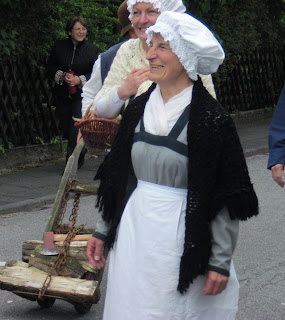
 Within an hour of Frankfurt are four Unesco World Heritage Sites. Only 35 minutes south is one of these sites and we happened to hit it on the day of an annual festival. The little town of Lorsch was abuzz with marching bands, special booths in the market place, festive activities for children in addition to a medieval parade with local citizens dressed in the garb of centuries past. They take their celebrations seriously, sparing no effort to relive, celebrate and otherwise find any reason to have a good time. German flare for harmonizing festive activities with entrepreneurial opportunities seems to have no limits. Here again they work hard, play hard and in times past, fought hard. This engaging combination works well for them. Germany is thriving economically, while at the same time saving the vestiges of times past through drama, music, holidays and celebrations. On each of their frequent holidays everything except local eating establishments close down and people are out mixing in their market places, commemorating, celebrating, enjoying the food, beverages and fruits of their toil.
Within an hour of Frankfurt are four Unesco World Heritage Sites. Only 35 minutes south is one of these sites and we happened to hit it on the day of an annual festival. The little town of Lorsch was abuzz with marching bands, special booths in the market place, festive activities for children in addition to a medieval parade with local citizens dressed in the garb of centuries past. They take their celebrations seriously, sparing no effort to relive, celebrate and otherwise find any reason to have a good time. German flare for harmonizing festive activities with entrepreneurial opportunities seems to have no limits. Here again they work hard, play hard and in times past, fought hard. This engaging combination works well for them. Germany is thriving economically, while at the same time saving the vestiges of times past through drama, music, holidays and celebrations. On each of their frequent holidays everything except local eating establishments close down and people are out mixing in their market places, commemorating, celebrating, enjoying the food, beverages and fruits of their toil.

We went to Lorsch to visit one of the sites recognized by Unesco - the only remaining free standing structure representing the Carolingian period. Others come close, but have been amalgamated with architectural styles of other time periods. The Carolingian period is perhaps the earliest time in which is manifested a truly Germanic form of architecture. It predates the Romanesque style which dominated the scene roughly from the 10th to 12th centuries. Prior to that time, Charlemagne and various factions including the Franconians, held sway in central Europe. Their influence on architecture, art and literature ruled the day. There is little left to represent this period and that is why this site was deemed worthy to receive the attention, albeit not through some majestic edifice or monument.
In Lorsch, an abbey was constructed in 764 by the then Emperor, on his own property, the intent of which was to solidify the link with Rome and Papal Christian supremacy. This Abbey with the acquisition of important relics of the time gained fame as a place of pilgrimage. In addition, it acquired an independent status, not subject to the clergy who tended to rule and sap the wealth of the communities under their stewardship.
The site itself was not particularly noteworthy from a visual standpoint, but the community of Lorsch has gone to great ends to provide visitors an understanding of what was previously there, its historical significance to Germany and the architecture of the time. To our good fortune the explanations were in English.
The gate depicted is the last remnant of what was an extensive abbey complex. Here were located significant artifacts including a library with substantive works on medicine and religion. It gained considerable favor and was endowed with privileges and lands thereby becoming politically powerful and rich.
On the same day, another 35 minutes down the road, we went to Speyer, also a World Heritage Site. The Romanesque Basilica, identified as an Imperial Cathedral, was founded by the Emperor Conrad II in 1030. It out measures all other structures of the 11th Century. The crypt is preserved in its original condition and houses the tombs of eight German Emperors, kings and several Bishops. This structure is considered to be a turning point in European architecture and one of the finest representations of Romanesque architecture of its time.
The vaulted ceilings provide a spacious impression. I walked from one end to other and counted 175 steps. Each of the 24 massive pillars occupy 48 square feet of floor space. The red sandstone adds a rich hue to the otherwise austere grandeur of this aging, but well preserved structure. It is quickly approaching its millennial consecration date of 1061.


No comments:
Post a Comment